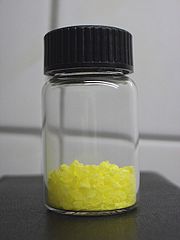User:Praseodymium-141/Niobium compounds
Niobium compounds are compounds containing the element niobium (Nb). In many ways, niobium is similar to tantalum and zirconium. It reacts with most nonmetals at high temperatures; with fluorine at room temperature; with chlorine at 150 °C and hydrogen at 200 °C; and with nitrogen at 400 °C, with products that are frequently interstitial and nonstoichiometric.[1] The metal begins to oxidize in air at 200 °C.[2] It resists corrosion by fused alkalis and by acids, including aqua regia, hydrochloric, sulfuric, nitric and phosphoric acids.[1] Niobium is attacked by hydrofluoric acid and hydrofluoric/nitric acid mixtures.
Although niobium exhibits all of the formal oxidation states from +5 to −1, the most common compounds have niobium in the +5 state.[1] Characteristically, compounds in oxidation states less than 5+ display Nb–Nb bonding. In aqueous solutions, niobium only exhibit the +5 oxidation state. It is also readily prone to hydrolysis and is barely soluble in dilute solutions of hydrochloric, sulfuric, nitric and phosphoric acids due to the precipitation of hydrous Nb oxide.[3] Nb(V) is also slightly soluble in alkaline media due to the formation of soluble polyoxoniobate species.[4][5]
Halides[edit]


Niobium forms halides in the oxidation states of +5 and +4 as well as diverse substoichiometric compounds.[2][3] The pentahalides (NbX
5) feature octahedral Nb centres. Niobium pentafluoride (NbF5) is a white solid with a melting point of 79.0 °C and niobium pentachloride (NbCl5) is yellow (see image at left) with a melting point of 203.4 °C. Both are hydrolyzed to give oxides and oxyhalides, such as NbOCl3. The pentachloride is a versatile reagent used to generate the organometallic compounds, such as niobocene dichloride ((C
5H
5)
2NbCl
2).[6] The tetrahalides (NbX
4) are dark-coloured polymers with Nb-Nb bonds; for example, the black hygroscopic niobium tetrafluoride (NbF4) and brown niobium tetrachloride (NbCl4).
Anionic halide compounds of niobium are well known, owing in part to the Lewis acidity of the pentahalides. The most important is [NbF7]2−, an intermediate in the separation of Nb and Ta from the ores.[7] This heptafluoride tends to form the oxopentafluoride more readily than does the tantalum compound. Other halide complexes include octahedral [NbCl6]−:
- Nb2Cl10 + 2 Cl− → 2 [NbCl6]−
As with other metals with low atomic numbers, a variety of reduced halide cluster ions is known, the prime example being [Nb6Cl18]4−.[8]
Oxides and oxyanions[edit]
Niobium forms oxides in the oxidation states +5 (Nb2O5),[9] +4 (NbO2), and the rarer oxidation state, +2 (NbO).[10] Most common is the pentoxide, precursor to almost all niobium compounds and alloys.[2][11] Niobates are generated by dissolving the pentoxide in basic hydroxide solutions or by melting it in alkali metal oxides. Examples are lithium niobate (LiNbO3) and lanthanum niobate (LaNbO4). In the lithium niobate is a trigonally distorted perovskite-like structure, whereas the lanthanum niobate contains lone NbO3−
4 ions.[2] The layered niobium sulfide (NbS2) is also known.[1] Materials can be coated with a thin film of niobium(V) oxide chemical vapor deposition or atomic layer deposition processes, produced by the thermal decomposition of niobium(V) ethoxide above 350 °C.[12][13]
Other compounds[edit]
Other binary compounds of niobium include niobium nitride (NbN), which becomes a superconductor at low temperatures and is used in detectors for infrared light.[14] The main niobium carbide is NbC, an extremely hard, refractory, ceramic material, commercially used in cutting tool bits.
See also[edit]
References[edit]
- ^ a b c d Nowak, Izabela; Ziolek, Maria (1999). "Niobium Compounds: Preparation, Characterization, and Application in Heterogeneous Catalysis". Chemical Reviews. 99 (12): 3603–3624. doi:10.1021/cr9800208. PMID 11849031.
- ^ a b c d Holleman, Arnold F.; Wiberg, Egon; Wiberg, Nils (1985). "Niob". Lehrbuch der Anorganischen Chemie (in German) (91–100 ed.). Walter de Gruyter. pp. 1075–1079. ISBN 978-3-11-007511-3.
- ^ a b Agulyansky, Anatoly (2004). The Chemistry of Tantalum and Niobium Fluoride Compounds. Elsevier. pp. 1–11. ISBN 978-0-444-51604-6.
- ^ Deblonde, Gauthier J. -P.; Chagnes, Alexandre; Bélair, Sarah; Cote, Gérard (1 July 2015). "Solubility of niobium(V) and tantalum(V) under mild alkaline conditions". Hydrometallurgy. 156: 99–106. doi:10.1016/j.hydromet.2015.05.015. ISSN 0304-386X.
- ^ Nyman, May (2 August 2011). "Polyoxoniobate chemistry in the 21st century". Dalton Transactions. 40 (32): 8049–8058. doi:10.1039/C1DT10435G. ISSN 1477-9234. PMID 21670824.
- ^ Lucas, C. R.; Labinger, J. A.; Schwartz, J. (1990). Robert J. Angelici (ed.). Dichlorobis(η5-Cyclopentadienyl)Niobium(IV). Inorganic Syntheses. Vol. 28. New York. pp. 267–270. doi:10.1002/9780470132593.ch68. ISBN 978-0-471-52619-3.
{{cite book}}: CS1 maint: location missing publisher (link) - ^ Soisson, Donald J.; McLafferty, J. J.; Pierret, James A. (1961). "Staff-Industry Collaborative Report: Tantalum and Niobium". Industrial and Engineering Chemistry. 53 (11): 861–868. doi:10.1021/ie50623a016.
- ^ Greenwood, Norman N.; Earnshaw, Alan (1997). Chemistry of the Elements (2nd ed.). Butterworth-Heinemann. ISBN 978-0-08-037941-8.
- ^ Pubchem. "Niobium oxide | Nb2O5 – PubChem". pubchem.ncbi.nlm.nih.gov. Archived from the original on 16 August 2016. Retrieved 29 June 2016.
- ^ Greenwood, Norman N.; Earnshaw, Alan (1997). Chemistry of the Elements (2nd ed.). Butterworth-Heinemann. ISBN 978-0-08-037941-8.
- ^ Cardarelli, Francois (2008). Materials Handbook. Springer London. ISBN 978-1-84628-668-1.
- ^ Rahtu, Antti (2002). Atomic Layer Deposition of High Permittivity Oxides: Film Growth and In Situ Studies (Thesis). University of Helsinki. hdl:10138/21065. ISBN 952-10-0646-3.
- ^ Maruyama, Toshiro (1994). "Electrochromic Properties of Niobium Oxide Thin Films Prepared by Chemical Vapor Deposition". Journal of the Electrochemical Society. 141 (10): 2868–2871. Bibcode:1994JElS..141.2868M. doi:10.1149/1.2059247.
- ^ Verevkin, A.; Pearlman, A.; Slstrokysz, W.; Zhang, J.; et al. (2004). "Ultrafast superconducting single-photon detectors for near-infrared-wavelength quantum communications". Journal of Modern Optics. 51 (12): 1447–1458. doi:10.1080/09500340410001670866.
Category:Niobium Category:Niobium compounds Category:Chemical compounds by element
